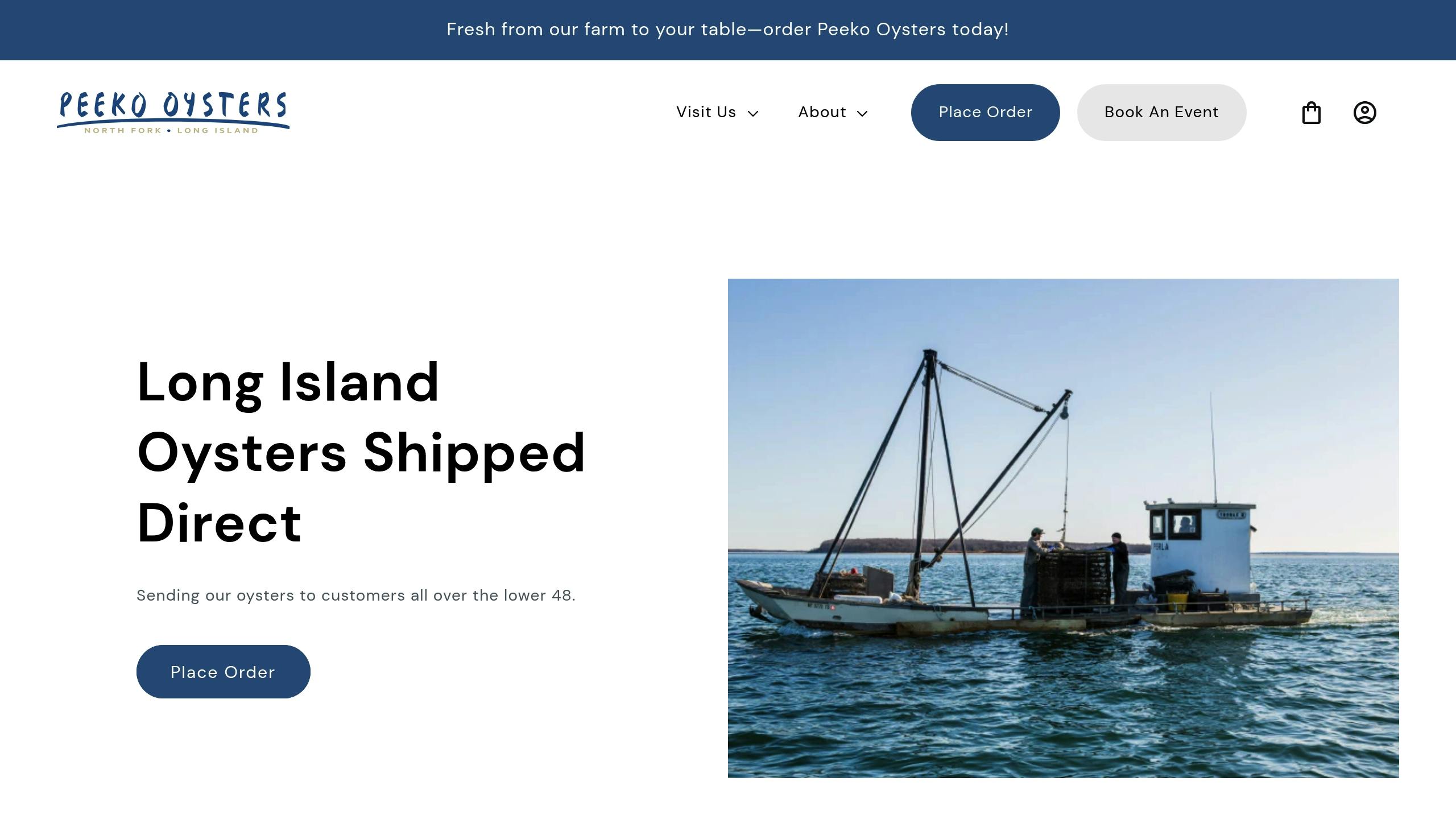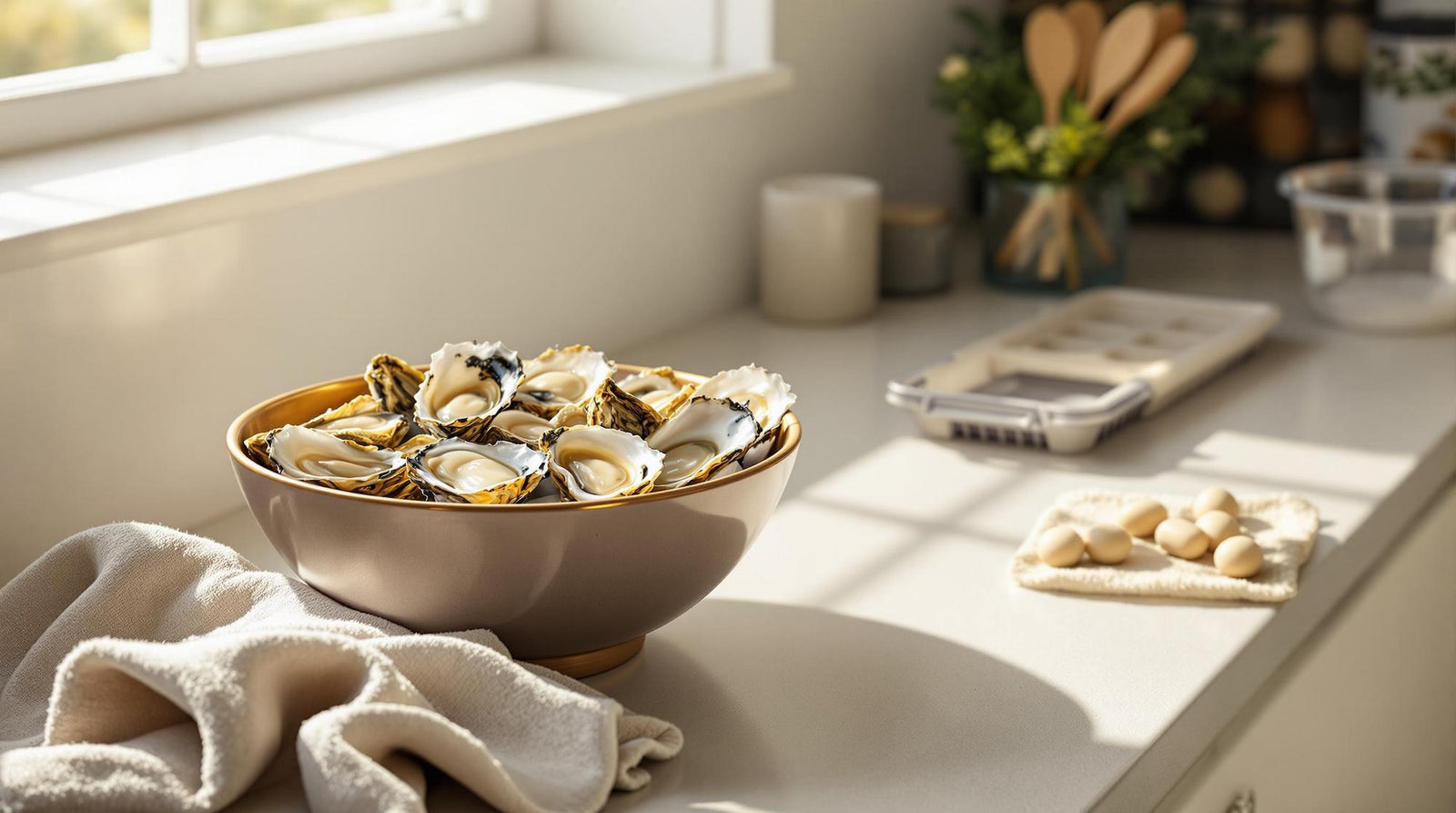Keeping oysters safe and tasting great starts with proper storage. Here’s what you need to know:
- Temperature matters: Store oysters between 33°F and 40°F to prevent bacterial growth.
- Let them breathe: Avoid airtight containers; use mesh bags or open trays with a damp cloth.
- No fresh water: Rinse briefly but never soak oysters in fresh water - it harms them.
- Avoid direct ice contact: Elevate oysters to keep them cool without touching melting ice.
- Inspect daily: Discard any with cracked shells, strong odors, or those that don’t close when tapped.
5 Major Storage Mistakes to Avoid
Using Fresh Water
Oysters depend on saltwater to keep their salt levels balanced. Exposing them to fresh water can be harmful or even deadly [1]. Avoid soaking oysters in fresh water; instead, give them a quick rinse to maintain their natural saltiness and flavor. Then, focus on proper storage methods to keep them fresh.
Sealing in Containers
Oysters need to breathe. Storing them in airtight containers traps moisture, leads to condensation, and suffocates them. Use an open container and cover it with a damp cloth or paper towel. Keep the humidity level between 85% and 90% to ensure freshness. Also, store oysters cup-side down to help them retain their natural juices.
Wrong Temperature
Oysters should be kept at or below 40°F to prevent bacterial growth. Freezing them is not ideal, as it damages their delicate tissues. The FDA advises keeping refrigerators at or below 40°F for proper storage. For shucked oysters, a temperature of around 32.9°F (0.5°C) can help prevent unpleasant smells [3]. Temperature control is key to keeping oysters in good condition.
Ice Contact
Direct contact with ice can be a problem. As ice melts, it becomes fresh water, which harms oysters and speeds up spoilage. To avoid this, elevate oysters above the melting ice water. This way, you can keep them cool without compromising their quality.
Skipping Shell Checks
Inspecting oyster shells regularly is crucial. Cracked shells or ones that don't close when tapped suggest the oyster might not be safe to eat. Dead oysters can harbor harmful bacteria, posing a food safety risk. Check your oysters daily, and discard any with damaged shells or those that don't close when gently tapped. It’s a simple step that can prevent serious issues.
How to Store Oysters Correctly
Maintain the Right Temperature
Set your refrigerator to stay between 33°F and 40°F. This range keeps oysters fresh, as they become inactive at 40°F, which helps preserve their quality [1]. However, temperatures closer to 33°F could shorten their shelf life.
Use a reliable thermometer to monitor the temperature where the oysters are stored. If you're using a cooler, add ice to maintain the right temperature, but make sure melted water doesn't touch the oysters. Also, pick a container that allows airflow and retains the right level of moisture.
Use the Proper Container
Live oysters store best in mesh bags because they allow air to circulate while keeping the oysters moist [4]. If they came in a mesh bag, keep using it. If not, opt for a shallow pan with drainage holes or a colander to prevent water buildup.
For added moisture control, cover the oysters with a damp cloth once they're in the container.
Handle and Position Carefully
Proper handling is just as important as temperature and container choice. Always place oysters with their natural opening facing upward - this helps them retain their liquor. Handle them gently to prevent shell damage.
To maintain moisture, cover the oysters with a damp paper towel. Replace the towel daily to minimize bacteria growth [4].
Inspect for Dead Oysters
Check your oysters regularly to ensure they're still good to eat. Discard any that:
- Stay open after being tapped
- Have cracked or broken shells
- Feel unusually light
- Smell strongly unpleasant
Avoid Food Cross-Contamination
Store Oysters Separately
Keep oysters away from other foods to reduce the risk of cross-contamination. Store them on the bottom shelf of your refrigerator to avoid any drips contaminating nearby items. This spot also helps maintain a steady temperature. Place a shallow tray under the container to catch any liquid.
"After two hours, bacteria present in the oyster will start to multiply and the likelihood of something causing an illness will go up. The oyster itself won't be bothered by this and will still look and taste just fine, so don't rely on that alone as a way to judge if they are safe to eat. This is the same rule that applies to all meat products. It is just extra important with oysters since the likelihood of them being eaten raw is pretty high." - Rogue Oysters [1]
In addition to proper storage, keeping tools clean is critical to avoid contamination.
Use Clean Tools
Using clean tools is crucial when handling oysters. Wash your hands thoroughly with soap and water both before and after handling raw oysters.
When preparing oysters for storage, follow these steps:
- Scrub the shells with a stiff brush
- Clean the hinge area to remove debris
- Rinse under cold running water
- Use tools dedicated solely to oysters
Make sure to use separate tools, cutting boards, and brushes for oysters. Clean everything with hot, soapy water immediately after use to stop bacteria from spreading.
sbb-itb-5051793
Peeko Oysters: How to store oysters at home

Storage Tools You Need
To keep your oysters in the best condition, make sure you have the right tools on hand.
Temperature Gauge
Keep an eye on storage temperatures with a reliable gauge set between 33–40°F. Tools like Timestrip PLUS TTIs can track temperature breaches above 50°F and even measure how long the temperature stays out of range - over 2- and 4-hour periods [5]. These indicators are easy to activate with just a press of your finger, helping you maintain safe storage conditions.
Moisture Control Cloth
Use a clean, food-grade cloth that’s damp enough to retain moisture without dripping. This balance is key - too much moisture can harm the oysters, while too little can dry them out. The cloth should allow airflow while keeping the oysters hydrated.
Breathable Storage
Opt for storage options like flat trays or mesh bags that promote airflow and evenly distribute weight. Avoid airtight containers, as oysters need to breathe to stay fresh and safe to eat.
Conclusion
To ensure oysters remain safe to eat and taste their best, it's crucial to store them correctly and avoid common mistakes.
"Mishandling is one of the greatest risks for foodborne illnesses caused by oysters, so please do your part" [2]
Keep oysters at temperatures between 33°F and 40°F to maintain their freshness. For the best quality, consume them within 7-10 days of harvest [1]. Proper storage goes beyond just keeping them cold. Use a well-ventilated container and control moisture levels to create the right conditions for keeping oysters alive and fresh.
"The most important principle to remember is that oysters should be kept cold until they're cooked or eaten, but there's a little bit more to it to keep them alive, fresh and safe" [1]
Check your oysters daily. Look for tightly closed shells, a fresh ocean-like scent, and adequate moisture. These are clear signs of a healthy and fresh oyster [2].





